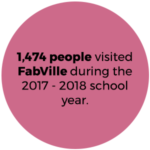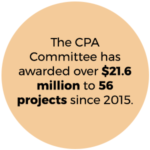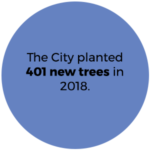The Resources section of SomerVision includes a number of goals relating to the community assets: cultural institutions, the arts, education, and gathering spaces. It explores our strengths and imagines how they can become even better in the future.

I. Increase the recognition of Somerville as a center of arts and creativity.
II. Ensure that Somerville has a mix of spaces for creative production, performance and exhibition, and that art is incorporated into the built environment.
III. Help local arts and cultural institutions, such as theaters, film and art festivals, museums and libraries to succeed, network and grow.
IV. Strengthen existing education programs and university and professional partnerships within Somerville schools.
V. Approach our waterfront as a regional ecological resource, balancing community access and ecological health.
VI. Create and program a network of vibrant public open spaces and shared use paths throughout the city that are multi-purpose, promote healthy living, and reflect changing recreational interests and cultural opportunities.
VII. Design and maintain a healthy and attractive public realm that fosters community connection, including streets, sidewalks, and other public spaces.
VIII. Maximize environmental sustainability in the design and implementation of all infrastructure systems and public facilities.
IX. Ensure the infrastructure for all utilities is sufficient in capacity and quality, of the best available technology, redundant, and supportive of the desired level of future growth.
X. Ensure that the Somerville municipal government, residents and business communities are well prepared and equipped to address emergency situations.
- Nibble: This Somerville Arts Council project provides culinary arts and entrepreneurial training to immigrants who are interested in turning their food into a business. They will be opening up their own space in Bow Market.
- Porchfest, ArtBeat, SomerStreets and other arts events: The Somerville Arts Council works tirelessly with other City departments and community organizations on free, inclusive events that incorporate a wide variety of people and artistic backgrounds. These support the creative economy
 and existing artistic community in the city.
and existing artistic community in the city. - Somerville Open Studios: This independent non-profit provides access to the work and spaces of visual artists living and working in Somerville through their events, including the namesake Somerville Open Studios event each Spring.
- FabVille: The Somerville High School and the City’s Economic Development Division collaborated to establish the city’s fabrication space using grant funding. The space provides classes for students and community members throughout the school year and encourages visitors to use the laser cutters, 3D printers, and other tools available at FabVille.
GET INVOLVED: Take a FabVille class yourself
- ArtFarm: This site was a waste transfer station, but is in the process of becoming something much more interesting. The 2.1 acres will serve as a park, urban agriculture site, and arts hub featuring the ArtFarm community center with performance and exhibit spaces. These uses will sit in conjunction with essential stormwater tank and pump infrastructure.
- West Somerville Library Renovation: The 109-year old West Branch of the Somerville Public Library will be undergoing extensive renovations starting in 2019. The result will be enhanced programming and resources, community space, and better accessibility.
 Community Preservation Act (CPA): In 2012, Somerville adopted the CPA with the support of over three-quarters of Somerville voters. As a result, a fund made up of a 1.5% surcharge on property taxes, municipal revenue, and distributions from the Commonwealth’s Community Preservation Trust Fund can be used to support projects relating to affordable housing, historic preservation, open space, and recreation land projects. The CPA has funded the acquisition of 0.17 acres of open space, contributed to the creation of 78 units of perpetually affordable housing, and funded a small grant program for local historic district property owners.
Community Preservation Act (CPA): In 2012, Somerville adopted the CPA with the support of over three-quarters of Somerville voters. As a result, a fund made up of a 1.5% surcharge on property taxes, municipal revenue, and distributions from the Commonwealth’s Community Preservation Trust Fund can be used to support projects relating to affordable housing, historic preservation, open space, and recreation land projects. The CPA has funded the acquisition of 0.17 acres of open space, contributed to the creation of 78 units of perpetually affordable housing, and funded a small grant program for local historic district property owners.- Beautiful Stuff Project: This community-oriented, independent nonprofit is a perfect example of the kind of resource sharing between cultural and educational institutions that SomerVision 2030 called for. The Beautiful Stuff Project is a “creative reuse center” which offers free and low-cost materials to community agencies, childcare centers, and public schools in Somerville and neighboring municipalities. The organization collects leftover scraps from manufacturers, stores, and artists and encourage people to use these materials “for educational, creative, and therapeutic purposes—and just plain fun!”
- The new Somerville High School: The new Somerville High School is probably one of the highest-profile projects underway in the city at the moment. The ambitious new campus will renovate 82,700 square feet of existing space and add new, state-of-the-art, energy efficient space for a total of over 320,000 square feet able to accommodate 1,590 students.
- SomerPromise: This department was established in 2012 to provide a cradle-to-career, cross-sector initiative aimed at identifying and reducing non-academic barriers to academic success. This team has created org, supported additional wraparound support services for teens, joined the Harvard Graduate School of Education’s By All Means project in 2016, co-facilitated an Out of School Time Taskforce with the Somerville Public Schools, and participated in a variety of other planning initiatives. They have also collaborated with the Somerville Family Learning Collaborative on SomerBaby—which is a welcome baby home visit program to help introduce families to community resources and conduct wellbeing screenings—and the annual Summer Camp and Activity Fair—which helps keep school-age children active and learning during the summer.
- Somerville Learning 2030: Somerville Learning 2030 (SL2030) is a visioning process to identify the Somerville community’s priorities for learning experiences and youth development, both inside and outside the classroom. Since this summer, over 500 surveys have been gathered and a dozen focus groups have been conducted in service of this new plan.
- Controlling invasive plants: At the time of SomerVision 2030, one of the priorities was water chestnut plants that were invading the Mystic River. The Mystic River Watershed Association has organized several events for volunteers to remove the invasive species. More recently, Black Swallow-Wort, which is a threat to Monarch butterflies, has been Invasive Species Enemy No. 1. The plant is toxic to many insect larvae, its roots are toxic to some mammals, and it releases a biochemical into the soil that discourages the establishment of other plant species.
GET INVOLVED: Learn more about Black Swallow-Wort
- Controlling invasive species: The Urban Forestry Division has been working to monitor, control, and help mitigate the damage from the Emerald Ash Borer (EAB). EAB, an invasive beetle from Asia can kill a tree within a few seasons. Somerville is home to more than 1,000 public Ash trees. EAB was first discovered in Somerville in 2018. Urban Forestry is working to treat healthy Ash trees, setting traps for EAB to monitor their path, and preemptively removing unhealthy Ash trees.
- State Park Improvements: DCR is working to improve state assets within Somerville including Draw Seven and Foss Parks. The Assembly Row developer, Federal Realty, improved Baxter State Park in 2013 to better access the Mystic.
- Park Renovation & Creation: There have been numerous additions to Somerville’s publically managed parks since SomerVision 2030. These include Zero New Washington, Quincy St. Open Space, Baxter Park, Chuckie Harris Park, North Street Veterans Park addition, Symphony Park, and the Community Path between Cedar and Lowell.
 Park Improvements: since 2004, 46 City-owned parks and schoolyards have been renovated—that’s 75%! In the last five years, these projects have averaged $2.1 million of investment each.
Park Improvements: since 2004, 46 City-owned parks and schoolyards have been renovated—that’s 75%! In the last five years, these projects have averaged $2.1 million of investment each.- Pavement and Sidewalk Management Program: In 2015, the City began using a data-driven approach to pavement management. This allows the City to make objective decisions using pavement condition data and information regarding other City capital improvements.
- Urban Forestry Department: Trees are an essential part of Somerville’s green infrastructure and provide numerous environmental and quality of life benefits. The City’s Urban Forestry Division manages, plans, and cares for the city’s 12,000+ public trees. One near-term priority is the development of an Urban Forestry Plan to develop a more long-term vision for Somerville’s trees.
GET INVOLVED: Become a tree steward
- Mayor’s Urban Agriculture Initiative: This initiative includes the passage of the first municipal Urban Agriculture Ordinance in New England, the Urban Agriculture Ambassadors Program, and the raising of the first City farms at South Street among other projects. The Urban Agriculture Ambassadors Program trains Somerville residents in urban agriculture for free in exchange for 30 hours of community volunteer service, which will provide more residents with the tools they need to successfully and safely grow food in an urban environment.
- LED Lighting: Since 2015, Somerville has converted all City-owned Streetlights to energy-efficient LEDs. This is projected to save the 2,103,000 kWh annually and to save the City nearly $1 million over 10 years. In addition, the City has made interior lighting energy efficiency improvements, including LED conversions, to 16 City-owned buildings, for an additional annual projected savings of 1,450,859 kWh.
- District Improvement Financing (DIF): This tool has been invaluable for using anticipated property appreciation to pay for necessary infrastructure improvements. For example, the necessary sewer separation project currently underway in Union Square was paid for in part by the Union Square DIF and a number of necessary infrastructure improvements in Assembly Square were funded by the Assembly DIF.
- Police training: The Somerville Police Department has continuously incorporated professional development to maintain a well-trained police force that is using established best practices. This has included dealing safely and appropriately to those with mental illness and mindfulness training for officers to better cope with the stresses of the job. The SPD has received several accolades since SomerVision 2030. They were recognized as a Certified Police Department by the Massachusetts Police Accreditation Commission in May 2017, they received the 2018 Best Community Police Department from the New England Chiefs of Police Association, and the Traffic Unit received the Gold Award from the AAA Community Traffic Safety Committee. In addition, SPD was selected as one of six police departments in the country to be featured in the National Law Enforcement Museum in their inaugural presentation efforts to improve police and community relations.
- Dialogue Series and community-oriented practices: The Police Department has organized Walking Dialogues with Teen Empowerment as well as dialogues specific to immigrants with the Human Rights Commission to better build relationships within the community. They were asked to present at the International Association of Chiefs of Police Conference to discuss their Youth Police Dialogue in 2018. The Police have also reemphasized the Park, Walk, and Talk model for policing and posted their policies online for public view to better build trust with residents.
- Police building improvements: Ensuring that the City’s police and fire departments have the facilities necessary to do their jobs remains a priority. Efforts are underway to build a new public safety building to serve a 21st Century police force and firefighting efforts on the easterly portion of the city.


